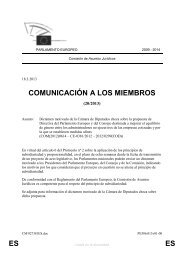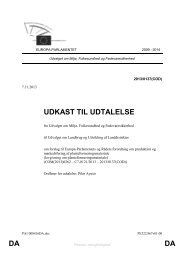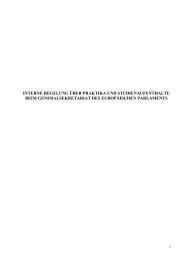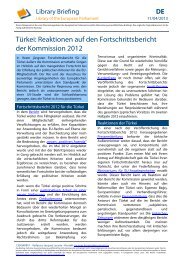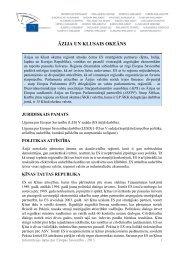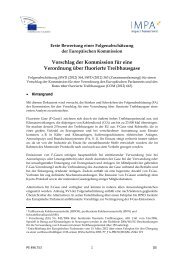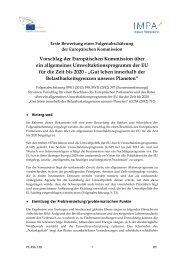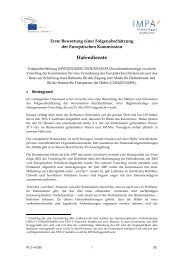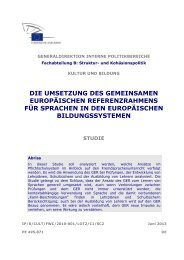- Page 1 and 2: PARLIAMENT AND DEMOCRACY IN THE TWE
- Page 3 and 4: ii I PARLEMENTS ET DÉMOCRATIE AU 2
- Page 5 and 6: iv I PARLIAMENT AND DEMOCRACY IN TH
- Page 7 and 8: vi I PARLIAMENT AND DEMOCRACY IN TH
- Page 9 and 10: viii I PARLIAMENT AND DEMOCRACY IN
- Page 11 and 12: x I PARLIAMENT AND DEMOCRACY IN THE
- Page 13 and 14: xii I PARLIAMENT AND DEMOCRACY IN T
- Page 15 and 16: 2 I PARLIAMENT AND DEMOCRACY IN THE
- Page 17 and 18: 4 I PARLIAMENT AND DEMOCRACY IN THE
- Page 19 and 20: 6 I PARLIAMENT AND DEMOCRACY IN THE
- Page 21 and 22: 8 I PARLIAMENT AND DEMOCRACY IN THE
- Page 23 and 24: 10 I PARLIAMENT AND DEMOCRACY IN TH
- Page 26 and 27: 2. A representative parliament The
- Page 30 and 31: A representative parliament I 17 se
- Page 32 and 33: Election rules and procedures to en
- Page 34 and 35: A representative parliament I 21 Th
- Page 36 and 37: A representative parliament I 23
- Page 38 and 39: A representative parliament I 25 ge
- Page 40 and 41: A representative parliament I 27 Fu
- Page 42 and 43: Foreign Affairs in the Norwegian St
- Page 44 and 45: A representative parliament I 31 Th
- Page 46 and 47: A representative parliament I 33 ca
- Page 48 and 49: A representative parliament I 35 re
- Page 50 and 51: ment to following through a process
- Page 52 and 53: A representative parliament I 39 An
- Page 54: A representative parliament I 41 In
- Page 57 and 58: 44 I PARLIAMENT AND DEMOCRACY IN TH
- Page 59 and 60: 46 I PARLIAMENT AND DEMOCRACY IN TH
- Page 61 and 62: 48 I PARLIAMENT AND DEMOCRACY IN TH
- Page 63 and 64: 50 I PARLIAMENT AND DEMOCRACY IN TH
- Page 65 and 66: 52 I PARLIAMENT AND DEMOCRACY IN TH
- Page 67 and 68: 54 I PARLIAMENT AND DEMOCRACY IN TH
- Page 69 and 70: 56 I PARLIAMENT AND DEMOCRACY IN TH
- Page 71 and 72: 58 I PARLIAMENT AND DEMOCRACY IN TH
- Page 73 and 74: 60 I PARLIAMENT AND DEMOCRACY IN TH
- Page 75 and 76: 62 I PARLIAMENT AND DEMOCRACY IN TH
- Page 77 and 78: 64 I PARLIAMENT AND DEMOCRACY IN TH
- Page 79 and 80:
66 I PARLIAMENT AND DEMOCRACY IN TH
- Page 82 and 83:
4. An accessible parliament The pre
- Page 84 and 85:
■ the fixed office; An accessible
- Page 86 and 87:
■ collaborating with NGOs in loca
- Page 88 and 89:
An accessible parliament I 75 Nowad
- Page 90 and 91:
ned against excessive reductions in
- Page 92 and 93:
An accessible parliament I 79 Furth
- Page 94 and 95:
An accessible parliament I 81 estab
- Page 96 and 97:
Extract from handbook on ‘Making
- Page 98 and 99:
An accessible parliament I 85 This
- Page 100 and 101:
■ a public record available on li
- Page 102 and 103:
An accessible parliament I 89 The N
- Page 104 and 105:
case in Switzerland, the country wi
- Page 106:
An accessible parliament I 93 since
- Page 109 and 110:
96 I PARLIAMENT AND DEMOCRACY IN TH
- Page 111 and 112:
98 I PARLIAMENT AND DEMOCRACY IN TH
- Page 113 and 114:
100 I PARLIAMENT AND DEMOCRACY IN T
- Page 115 and 116:
102 I PARLIAMENT AND DEMOCRACY IN T
- Page 117 and 118:
104 I PARLIAMENT AND DEMOCRACY IN T
- Page 119 and 120:
106 I PARLIAMENT AND DEMOCRACY IN T
- Page 121 and 122:
108 I PARLIAMENT AND DEMOCRACY IN T
- Page 123 and 124:
110 I PARLIAMENT AND DEMOCRACY IN T
- Page 125 and 126:
112 I PARLIAMENT AND DEMOCRACY IN T
- Page 128 and 129:
An effective parliament (I): The na
- Page 130 and 131:
Where parliaments lack capacity thr
- Page 132 and 133:
that the Senate, the House of Commo
- Page 134 and 135:
An effective parliament (I): The na
- Page 136 and 137:
consideration of a bill more effect
- Page 138 and 139:
National Assembly is currently in t
- Page 140 and 141:
An effective parliament (I): The na
- Page 142 and 143:
An effective parliament (I): The na
- Page 144 and 145:
An effective parliament (I): The na
- Page 146 and 147:
Oversight through parliamentary que
- Page 148 and 149:
An effective parliament (I): The na
- Page 150 and 151:
A case-study of oversight: security
- Page 152 and 153:
Anti-terrorist legislation An effec
- Page 154 and 155:
An effective parliament (I): The na
- Page 156 and 157:
An effective parliament (I): The na
- Page 158 and 159:
An effective parliament (I): The na
- Page 160 and 161:
An effective parliament (I): The na
- Page 162 and 163:
An effective parliament (I): The na
- Page 164 and 165:
An effective parliament (I): The na
- Page 168 and 169:
An effective parliament (II): Parli
- Page 170 and 171:
An effective parliament (II): Parli
- Page 172 and 173:
An effective parliament (II): Parli
- Page 174 and 175:
An effective parliament (II): Parli
- Page 176 and 177:
An effective parliament (II): Parli
- Page 178 and 179:
Japan’s ODA is effectively reachi
- Page 180 and 181:
An effective parliament (II): Parli
- Page 182 and 183:
An effective parliament (II): Parli
- Page 184 and 185:
An effective parliament (II): Parli
- Page 186 and 187:
An effective parliament (II): Parli
- Page 188 and 189:
An effective parliament (II): Parli
- Page 190 and 191:
An effective parliament (II): Parli
- Page 192 and 193:
An effective parliament (II): Parli
- Page 194 and 195:
An effective parliament (II): Parli
- Page 196 and 197:
8. Facing the future Facing the fut
- Page 198 and 199:
Figure 8.1: Sources of Parliamentar
- Page 200 and 201:
Facing the future I 187 State: give
- Page 202 and 203:
and also to allow for increased par
- Page 204 and 205:
strengthening of both legislative a
- Page 206 and 207:
As regards the practicability and c
- Page 208 and 209:
3. Technology assessment. This has
- Page 210 and 211:
Australia Austria Belarus Belgium B
- Page 212 and 213:
Organization’s programmes aimed a
- Page 214 and 215:
MS. MARTA LAGOS CRUZ-COKE Executive
- Page 216 and 217:
MS. DULCE MARIA SAURI RIANCHO Membe
- Page 218 and 219:
Commonwealth Parliamentary Associat
- Page 220 and 221:
Non-governmental organisations Cent
- Page 222 and 223:
Index Note: Page numbers in bold in
- Page 224 and 225:
types of, 8, 15-17, 69 voter partic
- Page 226 and 227:
Myanmar, 176 Namibia, 77, 110 Natio
- Page 228:
Sweden, 63, 75, 110, 112, 165 gende




